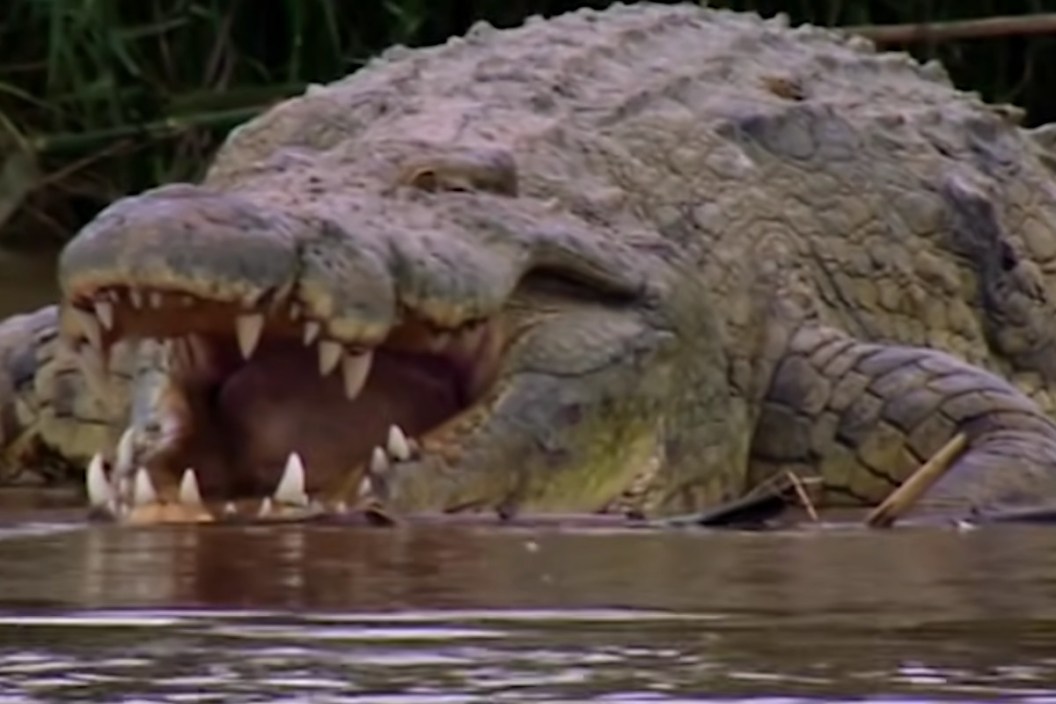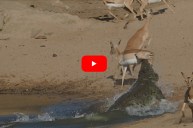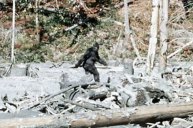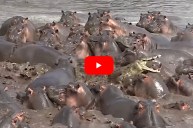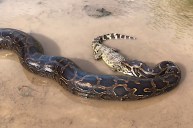Not much is more frightening than the thought of ending up as another link in the food chain. Fortunately, stories of true man-eaters have been mostly rare throughout history. Most animals simply don't see humans as natural prey. There are exceptions, of course. One of the biggest was a giant Nile crocodile known as Gustave, an animal that stalked the lakes and rivers of Burundi for more than 20 years. The giant reptile was allegedly nearly 20 feet in length, making it one of the largest crocodiles ever recorded in the wild. More frighteningly, Gustave was blamed for the deaths of over 300 humans. He allegedly snatched fishermen from boats and children from riverbanks in front of their parents. Other people vanished with no witnesses, only for mutilated remains to turn up later.
What's even more frightening about this story is the giant crocodile was never captured or killed, despite a bevy of attempts to end its reign of terror. In fact, some speculate that Gustav is still stalking people in Burundi to this day. This is the story of the most famous crocodile in recorded history and how he made an entire country's population afraid of the water.
The Killings Begin
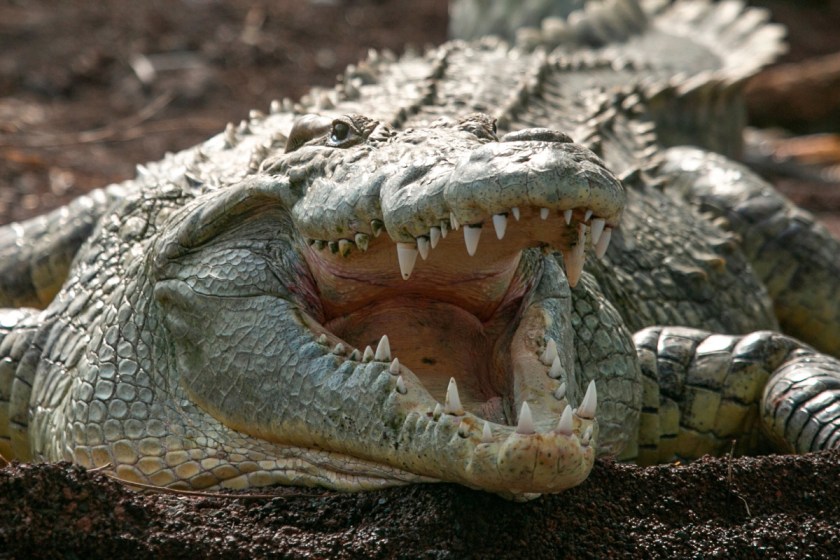
FARUK BUDAK via Getty Images
Burundi is a rather small African country south of Rwanda. Like Rwanda, it was frequently in the news for civil war and events of genocide between the Hutus and the Tutsis. Those conflicts caused the mostly local story of a killer crocodile to fall under the radar of the world media until the early 2000s. Gustave became famous thanks to a French expatriate named Patrice Faye. According to National Geographic, Faye sometimes hired a group of fishermen to help gather nature specimens for a museum in the capitol city of Bujumbura. One day in 1998, they told Faye a horrific tale.
"They told me that a colleague had been eaten by an enormous crocodile," Faye told National Geographic. "The fishermen recognized the croc; it came around sometimes, disappeared for a few years, and then came back to kill again."
Curious, Faye began researching and found a fascinating, if terrifying pattern of attacks along the shores of Lake Tanganyika dating back to 1987. Specifically, the villages of Minago, Magara, and Kanyosha were frequent places of attack. Every three years, there would be a short flurry of crocodile attacks between October and February before things calmed down again. Many of the victims were children who were swimming in the lake with their friends. Fishermen were also frequent victims. About a year later, a guide in Rusizi National Park told Faye about a huge crocodile that frequently went missing in the park, only to reappear mysteriously months later. No one knew where this animal went when it was gone. When it was in the park, it frequented the Ruzizi River and often chased smaller crocodiles out of his territory.
The park did have records on the times this one large crocodile went missing. When Faye compared those records with the times of the attacks in populated areas, he found they seemed to line up perfectly. Additionally, the large size of the crocodile in the park seemed to match the descriptions of the attacker seen by eyewitnesses. The animal was easily identifiable not just for his size, but for some distinctive scars on his head and back. Some of these have been speculated to be old bullet wounds from attempts to kill the animal. There are reports of soldiers shooting at Gustave to no effect, although it's also possible they were made by another crocodile or a hippopotamus. Still, Faye felt certain he had found the responsible serial killer and he quickly named the croc Gustave.
Gustave Becomes Famous
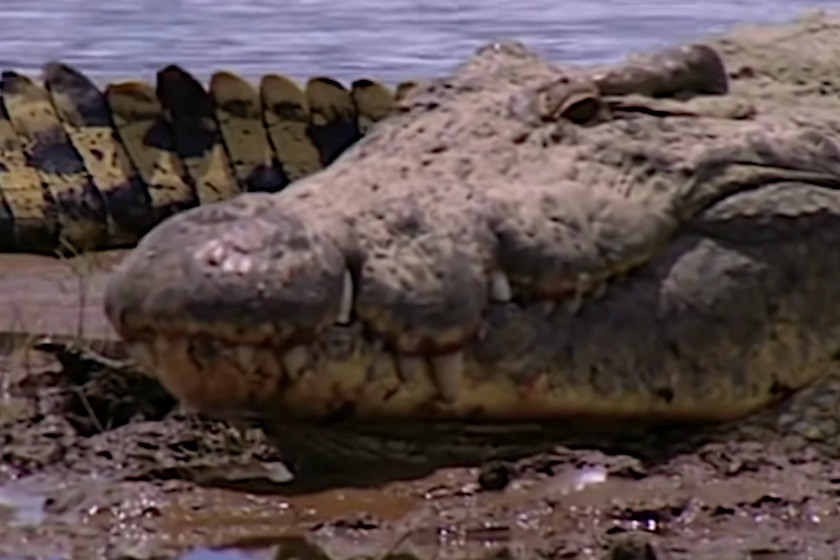
YouTube: MagellanTV
With a likely suspect identified, Faye helped popularize the legend of Gustave. He soon gave interviews to news organizations and the world quickly learned about the massive crocodile in Burundi that was snatching humans from the banks of Tanganyika. Because many of the victims were found uneaten, Faye claimed the big reptile was killing humans for sport, which only further fanned the flames.
Rumor had it was the crocodile was over a hundred years old. However, once scientists examined photos of Gustave, they noted it was likely he was far younger—mainly because he still had a full set of teeth. These days, conservative estimates put him anywhere from 50 to 60 years old at the time he became famous in the early 2000s. However, the main thing that got people's attention was his body count. News headlines around the world stated Gustave had 300 victims and counting, a massive number for any animal. While it is impossible to confirm the reports, there's no denying there are many grieving families along the shores of Tanganyika, many of whom saw their loved ones get taken by a monstrous croc they say was Gustave.
Thanks to the media attention, Faye was able to convince investors to send a documentary film crew to investigate and try to capture Gustave. Faye wanted the animal relocated away from people or put in captivity. He was convinced that once it was done, the killings in the lake would stop. The crew only had two months to search for the beast as political tension rose in Burundi again, the country teetering on the brink of yet another civil war.
Capture Attempts on Gustave

YouTube: MagellanTV
With researchers and a film crew on hand, the first organized attempt to capture Gustave was soon underway. The researchers knew from recent sightings a likely area where the crocodile was hiding. It didn't take long for them to visually confirm. With the killer reptile located, the hard part was figuring out a way to trap him alive. The researchers tried a large cage trap baited with huge chunks of meat first. They also equipped it with an infrared camera to hopefully record the capture. However, as the biggest animal in the area, Gustave proved to be far too wary of humans and avoided the trap. Worse, the giant croc allegedly claimed another victim while the trap was in place.
The expedition switched tactics and constructed a giant wire snare device. They captured some smaller crocodiles using this method, but Gustave again proved too smart for that scheme. Eventually, the expedition resorted to baiting the cage trap with chickens and a live goat. Cameras captured a large crocodile checking the bait from the water, but the crocodile never entered the trap.
Eventually, a storm destroyed the cage, and the scientists ran out of time to do their work. They left the country empty-handed. However, the resulting 2004 documentary, "Capturing the Killer Croc," was a huge hit when it aired on PBS and spread the legend of Gustave to an even greater audience, making the animal famous worldwide.
Later Sightings and the Truth Behind Gustave

BirdImages via Getty Images
After the documentary, reports of attacks slowed to a crawl. According to National Geographic, the last confirmed sighting of Gustave was in 2009. However, there are rumors of a sighting as recent as 2015. Without any video or pics to back it up, it's still just a rumor at this point. In 2019, it was claimed Gustav was finally killed, but there is no proof of this either. That seems to be the underlying theme behind stories of Gustave—the vague nature of the finer details. There's no doubt Gustave was, and possibly still is, very real. His victims were very real too. It's been confirmed he did kill many humans in Burundi, possibly over the course of nearly two decades.
However, many parts of the story of Gustave have been questioned by skeptics, and there are some real cracks in story. For instance, his real kill count. In 2011, Faye revealed to author Richard Grant that he only had documentation for about 60 deaths being attributed to Gustave. Even then, it's hard to confirm every fatal crocodile attack in Burundi at that time was done by the same animal. After all, Lake Tanganyika is a big body of water, and it's loaded with crocodiles.
Remember how Faye told reporters Gustave liked to "kill for sport?" Skeptical herpetologists have noted it's more likely the huge reptile was simply going after easy prey and then abandoning them when he realized the humans weren't his usual meal. A crocodile as large as Gustave may have had difficulty sneaking up on his usual prey items, which might make him more opportunistic, and prone to make mistakes when attacking. An unaware swimmer or bather would make for a slow and easy target.
There are other possible explanations for Gustave's behavior and why he started attacking humans in the first place. One disturbing theory is that many of the maimed but uneaten victims discovered later may have in fact been victims of the area's violence and genocide. These victims may have been dumped in the river knowing the famous crocodile would likely get the blame. Another disturbing theory states that Gustave may have developed a taste for humans when he scavenged victims of civil war that were dumped into the water further upriver in the Ruzizi.
Even Gustave's size is sometimes in question. While many reports put his length at 20 to 25 feet, the actual length of Gustave may be closer to 18 feet. In truth, without capturing or killing him, there's no way to know his true size. Nile crocodiles have rarely been recorded at lengths that large. For perspective, the largest saltwater crocodile ever held in captivity, Lolong, measured just over 20 feet, and that was a rare case.
Just like the case of the Tsavo man-eating lions, this story might be more greatly exaggerated than we realize. But since the story has taken on a life of its own, it's little wonder the people of Burundi still talk about this legendary reptile to this day. In the end, the story of Gustave serves as a stark reminder that humans have not truly conquered nature as we'd like to think, and that it's easy for us to end up back on the food chain in the right circumstances. Remember that the next time you wander into an area that holds predators on your next outdoor adventure!
For more outdoor content from Travis Smola, be sure to follow him on Twitter and Instagram For original videos, check out his Geocaching and Outdoors with Travis YouTube channels.
